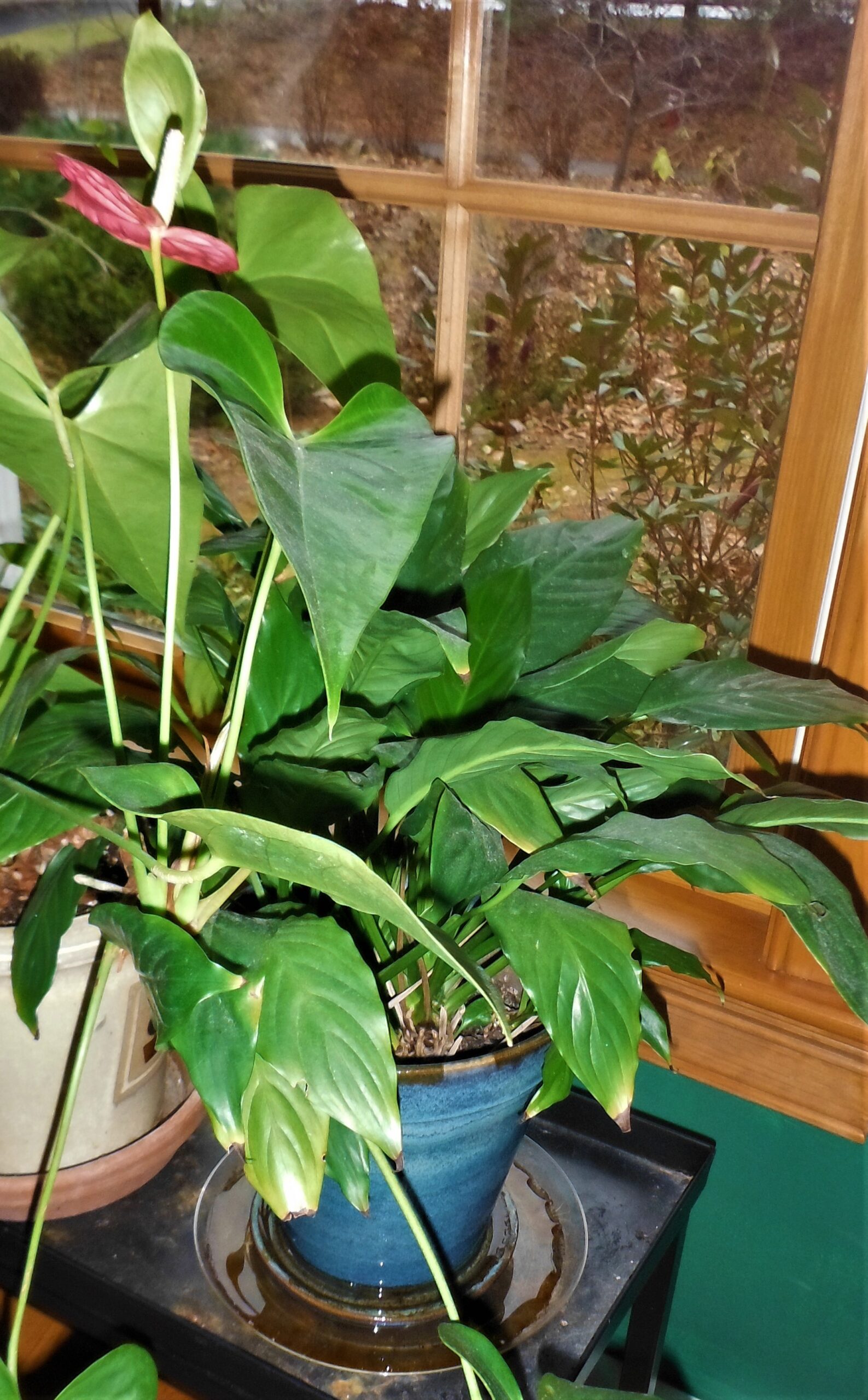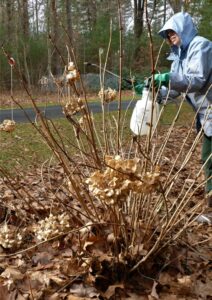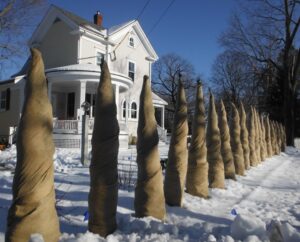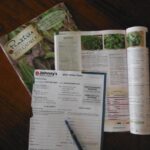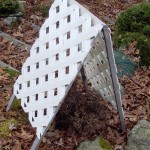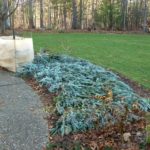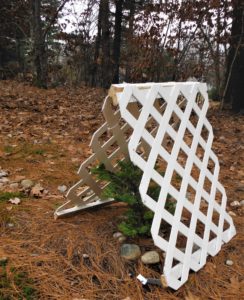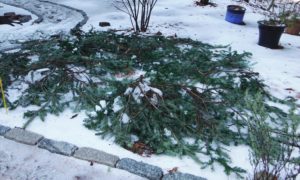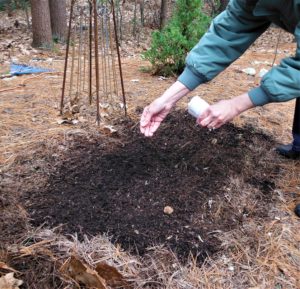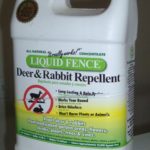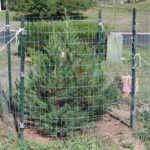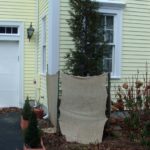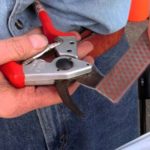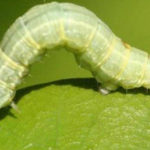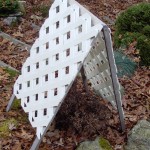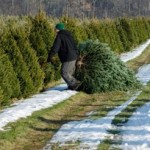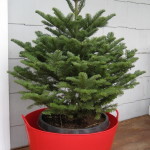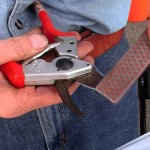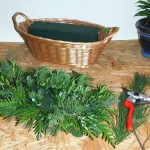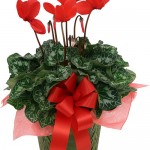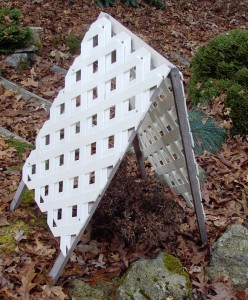Horticultural Hints – December
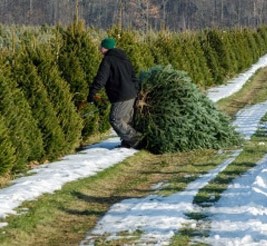 Cutting your own Christmas tree is better for the environment than buying one pre-cut. Precut trees are often transported long distances and many of them remain unsold on Christmas Eve, adding to the waste. A tree cut locally is fresher and cutting it yourself is great family fun. To find a “choose and cut” Christmas tree farms in Massachusetts go to http://www.christmas-trees.org/retailers-county.htm. After Christmas, cut the branches off the trunk and use them to cover gardens, keeping sleeping perennials can from suffering freeze and thaw cycles as the winter goes on.
Cutting your own Christmas tree is better for the environment than buying one pre-cut. Precut trees are often transported long distances and many of them remain unsold on Christmas Eve, adding to the waste. A tree cut locally is fresher and cutting it yourself is great family fun. To find a “choose and cut” Christmas tree farms in Massachusetts go to http://www.christmas-trees.org/retailers-county.htm. After Christmas, cut the branches off the trunk and use them to cover gardens, keeping sleeping perennials can from suffering freeze and thaw cycles as the winter goes on.
Caring for plants indoors. With central heating, our homes dry out in winter. Be certain your house plants aren’t suffering. Having ended up with water spots on furniture, I no longer mist houseplants. Instead, I set them in two saucers. One directly underneath the plant pot to capture any overflow from watering. A second, larger saucer holds water (replenished weekly) to assure the air around the plant does not dry out. By adding water as needed you are creating an environment in which houseplants can survive our indoor heating – and so can your furniture.
Protect your plants -1. There is no magic solution to protecting your plants from being ravaged by deer and other animals over the course of the next several months. But there are ways to make your plants unattractive to wildlife. The first step is to spray with a deer repellent (it also works on smaller mammals). The best of these products are the ones that contain putrefied egg and garlic. They smell terrible when sprayed on but, while the smell fades quickly from human noses, the taste remains and is bad enough to send deer elsewhere for up to a month. Respray monthly, but only if the outdoor temperature is above 40 degrees. Sometimes the memory of the taste will keep animals away longer, but always remember that a starving animal will eat anything.
Protect your plants – 2. A second line of protection is fencing. Most of us have no interest in surrounding our property with 7-foot or higher fences. Instead, fence the plants most likely to be eaten. Use the plastic mesh that has replaced chicken wire in gardening to invisibly wrap evergreens from the ground up to about 6 feet. The plant is not harmed and the deer cannot eat through the mesh. Why not use burlap? Wrapping evergreens in burlap limits sunlight getting to the live greens and can harm the plant.
Protect your plants – 3. Deciduous plants with an open framework of branches are best surrounded by a “stay-away” fence of chicken wire or burlap. Wrap vulnerable trunks of small or new trees with a paper or plastic tube designed to deter small animals from eating the bark. Remove the tube early in the spring to prevent any heat build-up as the sun gets stronger. Preventing animals from feasting on bark or leaf and flower buds, as well as tender branches, means a better spring for you and your plants.
Protect your plants – 4. Finally, when choosing new plants remember most natives evolved along with deer, and such plants have natural defenses. These can take the form of nasty tasting chemicals in their leaves and bark — protecting themselves so you don’t have to.
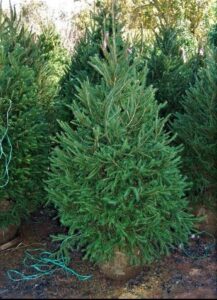
If you’re planning to purchase a live Christmas tree, dig the hole for its eventual home now and plant as soon after the holiday as possible
Live tree? Think ahead. With this year’s skyrocketing cost of cut Christmas trees, you may be thinking about purchasing a ‘live; tree that can be added to your landscape after the holidays. If a living Christmas tree is part of your plan, dig the hole now (before the ground freezes), cover the soil with a tarp and plan to plant it as soon as possible after Christmas Day. Water very well.
Make your outdoors winter-ready. Add a mulch of leaves over any perennial beds in your garden. Place pine needles over strawberry beds and cut down and dispose of raspberry and blackberry canes that fruited this year. Allow leaves to remain under bushes both as protection for the roots and as a home for many moths and butterflies that spend the winter in the leaves. In the spring their caterpillars provide food for the birds as well as beauty for your garden.
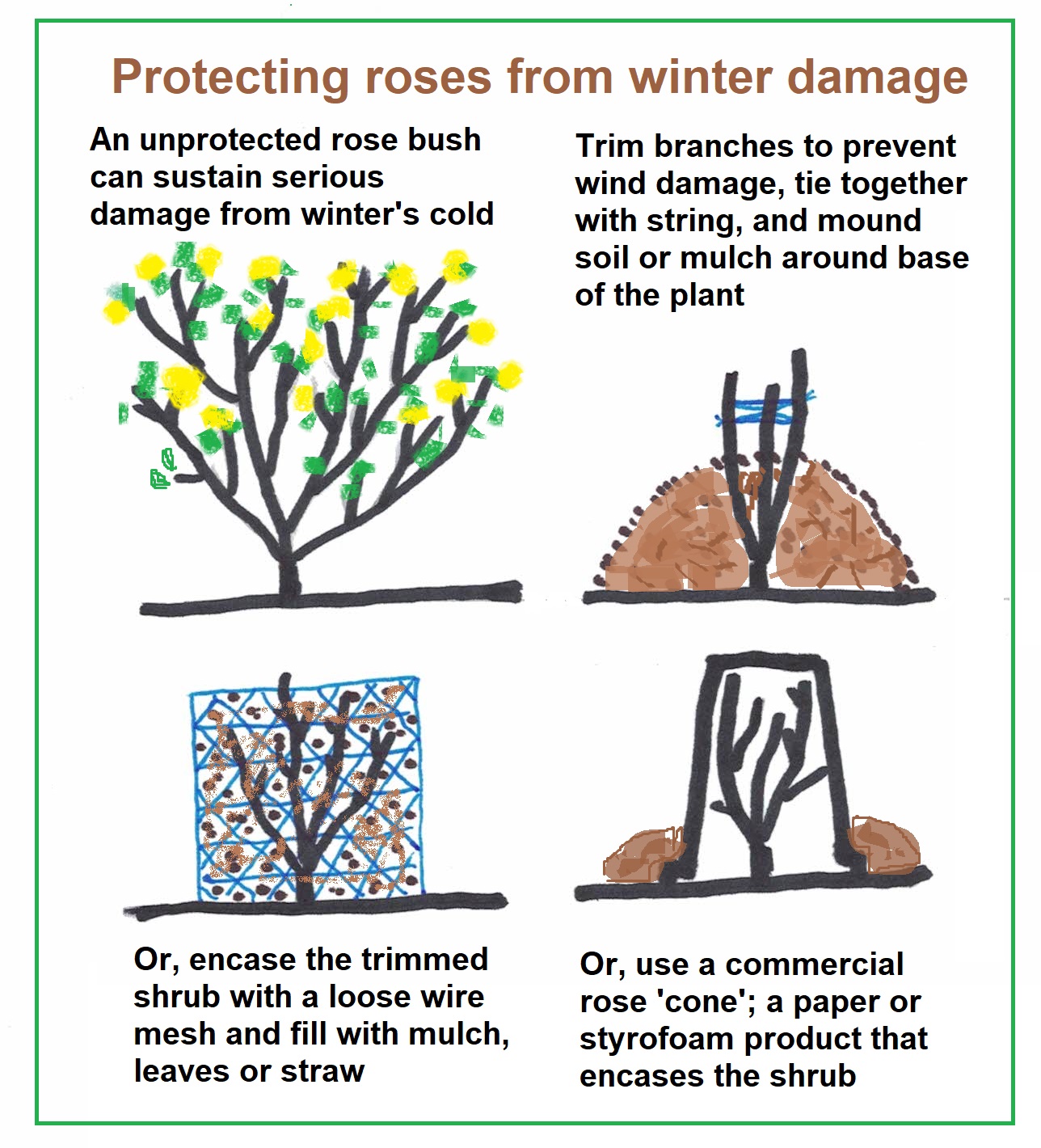 Winter Protection for Roses. If you live where temperatures dip below 5°F, you need to protect your roses. Your goal is to lessen the effects of freezing and thawing, and to keep branches from whipping about, which in turn causes roots to loosen. Begin by reducing stress on roses going into the dormant season by watering deeply in late autumn. Hybrid tea, grandifloras and floribundas should be protected from winter damage after a killing frost but before the soil freezes. Keep an eye on the forecast: when it says your area is in for several nights with temperatures in the ‘teens, that’s the time to take action. Here are three ideas:
Winter Protection for Roses. If you live where temperatures dip below 5°F, you need to protect your roses. Your goal is to lessen the effects of freezing and thawing, and to keep branches from whipping about, which in turn causes roots to loosen. Begin by reducing stress on roses going into the dormant season by watering deeply in late autumn. Hybrid tea, grandifloras and floribundas should be protected from winter damage after a killing frost but before the soil freezes. Keep an eye on the forecast: when it says your area is in for several nights with temperatures in the ‘teens, that’s the time to take action. Here are three ideas:
- Reduce breakage of tall canes by winter winds by cutting canes back to 24 to 30 inches and tying tips together. Remove dead and fallen leaves around the plants. Cleanliness now helps reduce disease next year. Mound soil over the center of the plants in broad, rounded mounds 8 to 12 high and 12 inches wide. Never use soil from the bed — you are robbing the roots to save the crown. You can cover the soil mounds with a mulch of leaves, straw, boughs or other, similar material.
- Some rose lovers use rose cones, baskets with bottoms cut out or burlap to wrap individual plants.
- To winterize climbers, remove them from their support. Lay them on the ground and cover with 3 to 4 inches of soil. If this cannot be done, gather the tips of the stems together, tie them, and wrap in straw with a wrapping of burlap over that. The base of the climber should be covered with 10 inches protection.
- When the first signs of growth appear in the spring, carefully remove most of the mulch and soil from around the bases of roses.
Protecting perennials now. One of the easiest ways to protect your perennials is to mulch the soil after the ground freezes. Once you have a covering of snow, it protects perennials from the damage of being thrust out of the ground during frost and thaw cycles (‘January thaws’). A covering of three inches of compost, hardwood mulch or evergreen branches can take the place of snow during dry winters or prolonged warm spells. And, come spring, the compost or leaves will improve the soil.
Indoor work. Have you cleaned your tools yet? Save tools – and time – in the spring by cleaning and sharpening metal tools such as trowels, shovels and hoes on those gray days and long, dark evening
Don’t wait to order seeds. Last spring, seed companies found themselves overwhelmed by orders from people wanting to start vegetable gardens amid pandemic shutdowns and shelter-in-place orders. Anyone who waited to order found not just their favorite seed varieties sold out, but also second- and third choices. Despite assurances they were increasing orders from their suppliers, a quick check in late November showed many favorite seed varieties are ‘not available at this time’. Don’t wait until the new year to put in your order; do it now.
Winterize your tools. Outdoor gardening season is over, so now it’s important to clean and organize your gardening equipment. Send your mower in for service (you won’t care if it’s not ready for three months). Wash the dirt off shovels, rakes and trowels. Then remove any rust with a piece of steel wool. Finish with by rubbing on a light coating of oil on all metal parts. Clean and sharpen edges pruners, loppers and other cutting tools. In the spring you’ll be glad you are ready to start gardening with like-new tools.
Inventory your tools. If you need a new shovel or you lost the hand hoe; put it on your list to Santa. There’s nothing like a finding new pair of high-quality pruners in your stocking.
Inventory your garage or garden shed, and note any old packages of herbicides and pesticides. Heat, cold and age all reduce the effectiveness of many of these products, but not their toxicity to the environment. Put them aside to dispose of at special collections centers or toxic material days held locally. NEVER place them in the trash or pour them down the drain or out on the ground. The environment you save is the one you and your family live, garden and play in.
Protect your shrubs. Any plant that regularly fails to thrive after a tough winter needs extra protection. You can use many of the same techniques that work for roses, for spring flowering hydrangeas that fail to bloom, as well as not-quite-hardy shrubs. Plants can be protected with wind screens, or cages stuffed with straw or leaves. Plants susceptible to branch break from heavy snow need special help. Tying branches together with heavy twine can be effective. For small plants, slatted structures allow good air flow while preventing crushing snow loads from building up.
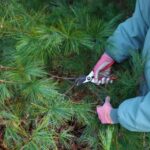 Decorating. Pruning evergreens now has a second benefit. You can use the cuttings to make holiday arrangements! Cuttings from spruce, cedar, pine and fir make great decorations on their own and elegant arrangements especially when combined with flowers for special occasions. Conversely, don’t bother bringing in hemlock; it sheds its needles almost immediately. Similarly, holly must be kept in clean water and will still have a short life span. Leave the winter berries for the birds that need them for food. They fall off and can a danger to small children or pets who find them on the floor.
Decorating. Pruning evergreens now has a second benefit. You can use the cuttings to make holiday arrangements! Cuttings from spruce, cedar, pine and fir make great decorations on their own and elegant arrangements especially when combined with flowers for special occasions. Conversely, don’t bother bringing in hemlock; it sheds its needles almost immediately. Similarly, holly must be kept in clean water and will still have a short life span. Leave the winter berries for the birds that need them for food. They fall off and can a danger to small children or pets who find them on the floor.
Protect against freeze and thaw. Winter is tough on your perennials and bulbs, but it isn’t the cold that poses the greatest danger. Instead, it’s the freeze-and-thaw cycle of early and late winter that can – quite literally – pop plants out of the ground. Once the ground is frozen in your perennial beds and over bulb plantings, add a layer of straw, pine needles or (better yet) branches cut from evergreens that will not pack down over the winter. Evergreens should be mulched with a heavy layer of straw or leaves to protect the roots.
Protect against Thumper and friends. Newly planted trees and fruit trees are magnets for hungry rabbits and rodents whose regular food supply is substantially reduced by the onset of winter. Wrap vulnerable trees and shrubs with wire mesh or heavy paper to make those plants harder to get to.
One last trip up the ladder. The strong winds we experienced in late November likely filled your gutter with plant debris and, especially, pine needles. Before downspouts become clogged and ice up, take a few hours to do a final clean-out of accumulated material. Those hours will mean far fewer problems once sub-freezing temperatures become the norm.

If you’re planning to purchase a live Christmas tree, dig the hole for its eventual home now and plant as soon after the holiday as possible
Live tree? Think ahead. If you are planning for a living Christmas tree to be planted outside after the holiday, dig the hole now, cover the soil with a tarp and plan to plant it as soon as possible after Christmas Day.
Break the salt habit. Home improvement and hardware stores are filled with bags of salt-based de-icers for your sidewalk and driveway. Leave them be. Instead, use sand to make your sidewalk and driveway safe. Why avoid salt? Because it will cause serious damage your lawn or plantings along the pavement. Also, while sometimes recommended, using fertilizers as de-icing agents leads to over-fertilizing and can kill plants and lawns.
Houseplant check-up. Problems pop up quickly inside our hot, dry houses. Keep an eye on plants, particularly the ones that have had problems in the past. Gift and other new plants should be kept separate from your stalwarts. If they’ve brought unwanted baggage – such as disease or insects – you’ll be able to catch the problem before it spreads.
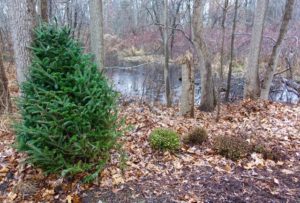
After the holiday, your Christmas tree can have a second life as a shelter for birds and other wildlife
Recycle your tree. When the tree comes down, recycle it. Tie it up in your yard as a shelter for birds during winter storms. Find out if your town recycles trees by turning them into mulch, or using them to protect the sea shore from winter storm erosion. You can cut off the tree’s branches and use them to cover new or tender plants to protect them from winter winds and freeze-and-thaw cycles (and, no, the needles won’t harm your plants or the soil chemistry). If you use an artificial tree, store it carefully so there’ll be no need to replace it next year.
 Support a Garden with a financial gift. When sending out year-end gifts to charities, remember that gardens and garden societies need support too. Your gift may come with a membership that will encourage you to make more visits, take more classes, see more exhibits and become a better gardener yourself.
Support a Garden with a financial gift. When sending out year-end gifts to charities, remember that gardens and garden societies need support too. Your gift may come with a membership that will encourage you to make more visits, take more classes, see more exhibits and become a better gardener yourself.
If you haven’t already, mulch your perennials and newly planted bulbs and to protect young trees from hungry rodents. Place a mulch of pine needles, chopped leaves, or wood chips to prevent heaving of plants out of the soil during alternating freeze and thaw cycles. Wrapping the stems of young trees to a height of two to three feet with small mesh wire or plastic trunk guards will protect trees from gnawing damage by mice, moles and other vermin.
Act now to protect your shrubs from winter storms. To avoid wind- or snow-caused broken branches on evergreens and shrubs, tie up the branches with rope or mesh fencing. Burlap wind breaks can provide important protection for boxwood and broad-leafed evergreens such as rhododendrons and azaleas. While you may see others doing so, resist the temptation to tightly wrap trees or shrubs with burlap. Burlap provides good shelter for rodents and other animals while preventing the plant from receiving sunlight throughout the winter.
It’s also time to start regular sprayings of shrubs and small trees with vile-smelling solutions such as Bobbex and Deer Off to prevent browsing of tender tips by hungry deer. You’ll need to keep up that regimen monthly throughout the winter to be effective.
If you use cut evergreen branches for holiday decorating, don’t throw them away when the season is over. In January, the branches can provide protection for low growing plants that might otherwise be crushed or broken by snow. Also, when putting up (and taking down) outdoor Christmas lights on trees and shrubs, take care not to break off the buds that will be next spring’s flowers.
Houseplants need regular misting during winter months to prevent damage from the dry air in our homes. Or you can place pots on saucers or trays with a layer of stone. If the stones are kept wet, the evaporating water will add humidity without risking root rot in your plants.
December is also the time to plant seeds for hardy annuals such as cleome, bachelor buttons, snapdragons, snow on the mountain and, for next year’s monarch butterflies, milkweed.
Finally, choose a cold, damp day to finish cleaning and oiling all your wood and metal tools and sharpen pruners so they are ready to get to work next spring.
Protecting your plants. There is no single, magic solution to protecting your plants from being ravaged by deer and other animals. But there are ways to make yours the least attractive plants around.
Your first line of defense is to spray with deer repellent. These sprays also work to deter smaller mammals. Trial and error has taught me the best of these products are the ones that contain putrefied egg and garlic. These products smell terrible when first sprayed on but, to human noses, fades after an hour or two. To animals, though, the taste remains and is bad enough to send deer elsewhere for up to a month. During winter months you should re-spray monthly, but only if the temperature is above 40 degrees. Sometimes the memory of the taste will keep animals away longer, but always remember that a starving animal will eat anything.
A second line of protection is fencing. Most of us have no interest in (or resources for) surrounding our property with seven-foot or higher fences. On my property, we fence the plants most likely to be eaten. We use the plastic mesh that has replaced chicken wire in gardening to invisibly wrap evergreens from the ground up to about 6 feet. The plant is not harmed and the deer cannot eat through the mesh. Wrapping evergreens in burlap limits sunlight getting to the live greens and can harm the plant. A loose burlap ‘fence’ around a prized evergreen is an alternative.
Deciduous plants with an open framework of branches are better surrounded by a “stay-away fence of chicken wire or burlap. Wrap vulnerable trunks of small or new trees with a paper or plastic tube designed to deter small animals from eating the bark. Remove it early in the spring to prevent any heat build-up as the sun gets stronger. Preventing animals from feasting on bark or leaf and flower buds, as well as tender branches, means a better spring for you and your plants.
Finally, go native when choosing new plants. Keep in mind that most native plants evolved along with deer, and so have natural defenses (think nasty tasting chemicals in their leaves and bark) to protect themselves from foragers so you don’t have to.
* * * * *

The continuing Northeastern drought means you need to continue to water newly planted trees until the ground freezes
Keep Watering. If the ground hasn’t frozen when you read this, keep watering. The Northeastern drought has gotten worse because the autumn rains are below the long term averages, and we saw a significant shortfall in summer precipitation. Water trees and shrubs – those planted in the last few years – first. A good soaking of ten gallons will help the shrubs fill their roots and branches with the last water they will see until the ground thaws in the spring. Trees need 20 gallons or more. Perennials and bulbs are on their own until spring when we will (hopefully) have had enough snow to refill the soil and the aquifers we depend on.
Tool clean-up. If you haven’t already cleaned up your tools for winter, do so now. It’s much easier to take a morning or afternoon now to remove dirt and rust from lawn tools than it will be in the spring. After it is clean and dry, sharpen any tools in need and then coat the metal parts with oil and give the wood a thin layer of wax. In the spring, you’ll be happy you took the time now.
What to do outside. Put a leaf or pine needle mulch over any beds of perennials. Place pine needles over strawberry beds and cut down and dispose of raspberry and blackberry canes that fruited this year. Allow leaves to remain under bushes both as protection for the roots and as a home for many moths and butterflies that spend the winter in the leaves. In the spring those caterpillars will provide food for the birds as well as beauty for your garden.
Be on watch for winter moths. If you see large numbers on your property in December, be prepared to apply horticultural oil to trees on an early spring day when the temperature is above 45 degrees. The application of horticultural oil is important in order to not harm your trees. The oil smothers the eggs before they hatch. While you won’t get them all because the eggs are often under the edges of bark or otherwise hidden, you’ll limit damage.
Once they have begun to hatch into caterpillars, be ready to spray your trees with BKT—a caterpillar-specific product that is activated in the stomach of the winter moth and then kills it. BKT may also kill beneficial Lepidoptera if they are out eating on the same trees. You will need to be vigilant and ready to spray when you see winter moth caterpillars. At this point there is no foolproof way to rid your property of these pests, but you can help vulnerable trees and shrubs (such as blueberries) survive while we wait for biologists to find the secret bullet.
Previous December hints:
Protecting Plants. Not every winter will set records like last year, but new or tender plantings may still need help. If you took advantage of fall nursery sales, or if you used the warm weather to work on your garden and you moved a few plants, give those plants the extra protection they’ll need. Wind screens or cages stuffed with mulch, straw or leaves will protect from both drying winds and temperature fluctuations. Plants susceptible to having branches broken by ice or heavy snow need special help. Tying branches together with heavy twine can be effective. For small plants, structures allow good air flow while preventing crushing snow loads from building up. Never wrap plants in plastic or burlap. It deprives them of light and fresh air, and provides a comfy home for rodents who will then dine on the bark.
Cutting your own Christmas tree is better for the environment than buying one pre-cut. Precut trees are often transported long distances and many, many of them remain unsold on Christmas Eve, adding to the waste. A tree cut locally is fresher and cutting it yourself is great family fun. To find a “choose and cut” Christmas tree farms in Massachusetts go to http://www.christmas-trees.org/retailers-county.htm. After Christmas, cut the branches off the trunk and use them to cover gardens, keeping sleeping perennials from suffering freeze and thaw cycles as the winter goes on.
Live Christmas trees are a wonderful way to make Christmas a permanent part of your home landscape. If you consider a live Christmas tree, there are a few rules to follow. Before choosing a site in your landscape for the new tree, be certain to take into account its ultimate size. Today’s six-foot balsam wants to grow to 75 feet high and 25 feet wide. Dig the hole now, before the ground freezes. Remember: it should be three times as wide as the root ball and just as deep as the root ball is tall. Keep excess soil covered with a tarp so it is ready to be put back in the hole no matter the weather between now and your planting date. Live trees should be in the house for no more than 3 or 4 days. Before bringing it indoors, make certain it is well watered and, once indoors, kept away from heat sources. After planting, mulch the tree with 3 to 4 inches of wood chips or similar material. Continue to water your tree until the ground around it is frozen solid. Adding protection from direct sunlight and harsh winds with a burlap screen helps the new tree through the winter. In the spring, resume the watering for the next three years.
Winterize your tools Outdoor gardening season is over, but it’s important to clean and organize your gardening equipment now. Send your mower in for service and you won’t care if it’s not ready for three months. Wash the dirt off shovels, rakes and trowels. Then remove any rust with a piece of steel wool, and finish by rubbing on a light coating of oil. Clean and sharpen edges pruners, loppers and other cutting tools. In the spring you’ll be glad you can start gardening with like new tools.
It’s also a good time to do an inventory. If you need a new shovel, you lost the hand hoe; put it on your list to Santa. There’s nothing like a finding new Felco pruners under the tree.
After the water, mulch. We all use mulch in the summer to keep weeds down and improve water retention, but it also has a role to play in the winter. A layer of mulch applied now will help prevent plants being dislodged by cycles of freezing and thawing. Cold weather doesn’t kill hardy plants, but being pushed out of the soil by mid winter thaws will. A layer of chopped leaves is a great winter mulch that will mostly break down to improve the soil by spring. Who could ask for more than protection and compost in one?
Get ready for spring—clean up your tools. Outdoor gardening season is over, but it’s important to clean and organize your gardening equipment now. Send your mower in for service and you won’t care if it’s not ready for three months. Wash the dirt off shovels, rakes and trowels. Then remove any rust with a piece of steel wool, and finish by rubbing on a light coating of oil. Clean and sharpen edges pruners, loppers and other cutting tools. In the spring you’ll be glad you can start gardening without like new tools.
It’s also a good time to do an inventory. If you need a new shovel, you lost the hand hoe; whatever it is, put it on your list to Santa. There’s nothing like a finding a pair of Felco pruners under the tree.
Reindeer welcome, deer not! If deer are a regular problem for you, there are two steps to take to improve your plants chances of surviving without being “pruned” this winter. First, when the temperature goes over 40° you can spray the trees with a readily available repellents made from putrefied eggs and garlic. The smell disappears for you in a few hours, but it continues to deter the deer for up to a month.
Second, wrap those plants the deer prefer with black plastic wire and secure it to stakes placed a few inches away from the plants. The fencing will be virtually invisible to anyone admiring your winter landscape, but effective at keeping the deer from nibbling your trees and shrubs to death. Small plants (those under four feet) should also have a piece of fencing secured over the top so the deer cannot simply reach in to dine.
Houseplant check-up—Problems pop up quickly inside our hot, dry houses. Keep an eye on plants, particularly the ones that are new or have had problems in the past. Catch it quickly and you’ll have the best chance of beating the mites or white flies or scale—or whatever appears.
Evergreen arrangements—Create inexpensive seasonal arrangements by cutting evergreens, especially pine, spruce and firs, arranging them in a shallow dish or in floral foam. Then cut the flowers from a supermarket bunch of red carnations or white baby’s breath to size and you’ll have added a great holiday centerpiece to your home.
December 2012 and previous years
Keep off the grass! Once lawns become frozen, you should stay off them. However, if they haven’t yet frozen, you can continue with fall chores such as liming your yard, continuing to mow in leaves and add chipped leaves or compost to flower and shrub beds. Don’t add any fertilizer at this time, it’s too late to do any good this year.
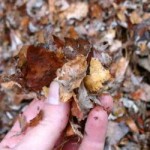
Want leaf mulch for your beds? Fiil a garbage can with leaves, then use a string trimmer to chop the leaves into fine pieces.
But do rake your beds. I usually rail against raking, but you can hardly mow your flower or shrub beds. Rake leaves from the beds into a pile and fill a trash can. Then use a string trimmer to chop the leaves into fine pieces. Put the chopped leaves back around (but not up against!) perennials and shrubs. This will help prevent plants from being heaved out of the soil by freezing and thawing cycles and will add nutrients and organic matter to the soil as they break down over the winter.
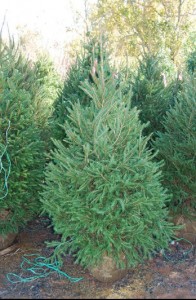
A living Christmas tree can create memories for years to come. It takes planning to transition the tree from outdoors to indoors, and then to its permanent home.
Living Christmas trees are a great way to add a new tree, complete with memories, to your yard. To give it the best chance to do well after Christmas, treat your tree carefully before the holiday. When you get the tree home, you should keep it in a sheltered location where it is not exposed to drying winds or direct sunshine. Water the root ball frequently because your living tree needs a continual supply of water. Move the tree into a garage or unheated room for a few days before setting it up in the house. Once in the house, keep your tree in a heated room, and leave it decorated for the briefest time your family will allow – three or four days if at all possible.
As soon as you bring your tree home you should prepare its permanent home. First, decide where you’re going to put the tree after the holidays. Keep in mind that today’s six-foot balsam will ultimately grow to 75 feet high and 25 feet wide. Dig a hole as deep as the root ball and three times as wide (measure these before you start) where you plan to plant your tree. Covering the hole and soil with a tarp should help to keep it from freezing until you are ready to plant. Once the tree is planted, water it every couple of days until the ground freezes. Three to four inches of mulch over the freshly dug area will help the tree by keeping the moisture in the soil and giving it a few extra days before the soil freezes and the water is no longer available to the branches.
This may read like a recipe for hard work, but all that is required is an understanding that you’re taking an outdoor evergreen that has already gone through the shock of having much of its roots shorn off. Easing it into and out of the further shock of an artificial ‘spring’ (several days in your home plus the heat of lights on its branches) helps ensure that your evergreen will survive once planted. The payoff, though, can be worth the effort. Years from now, you and your family will be able to point to a tall, perfectly formed evergreen and say, “that was the Christmas of 2012.”
Holiday plants. If you looked at the ads and in the stores, you might think that poinsettias were the only plant with which to decorate for the holidays. But they can be temperamental plants that drop all their leaves after a single cold draft and sulk when they receive too much water. Traditionally, Christmas cactus has been a favorite of many families where cuttings from grandmother’s plant may have graced many homes. My personal favorite is cyclamen which offer a broad range of colors and an ability to keep blooming for several months. They prefer bright light and cool rooms. A biweekly feeding will keep them blooming to March. As soon as the soil thaws, plant them outside in a shady space and watch for more blooms. By bringing them back indoors in early October, I have kept the same plants for nearly ten years.
How to care for your indoor gardens. Stop fertilizing and slow down watering for next 40 days. House plants are getting much less light and they want to rest. Fertilizing tells the plant to grow when, unless you are growing under lights, it doesn’t have the energy (from light) to do so. Cactus shouldn’t see any water until March unless you see shrinking from dehydration.
Gardening gifts. Gardeners are easy to shop for—they always want a new tool, a new book or a new plant. If you are hesitant about what they’d like, give them a gift certificate from a favorite local nursery. Want something more personal? Give your favorite gardener a books of “coupons” good for an hour of weeding, of digging holes, or clean-up in the spring.
Hints from previous Decembers: December 2011
Keep Mowing. November was unseasonably warm. As a result, grass – which prefers cool weather – is still growing and you need to keep cutting it until the first killing frost. The upside to this is that with each mowing you are further chipping the leaves, speeding their return to the soil as nutrients. Once the ground freezes, stay off the grass to prevent damage to the crowns of the plants.
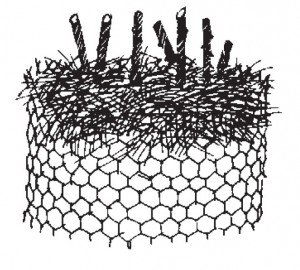 Winter Protection for Roses. If you live where temperatures dip below 5°F, you need to protect your roses. Your goal is to lessen the effects of freezing and thawing, and to keep branches from whipping about, which in turn causes roots to loosen. Begin by reducing stress on roses going into the dormant season by watering deeply in late autumn.
Winter Protection for Roses. If you live where temperatures dip below 5°F, you need to protect your roses. Your goal is to lessen the effects of freezing and thawing, and to keep branches from whipping about, which in turn causes roots to loosen. Begin by reducing stress on roses going into the dormant season by watering deeply in late autumn.
Hybrid tea, grandifloras and floribundas should be protected from winter damage after a killing frost but before the soil freezes. Keep an eye on the forecast: when it says your area is in for several nights with temperatures in the ‘teens, that’s the time to take action. Here are three ideas:
- Reduce breakage of tall canes by winter winds by cutting them back to 24 to 30 inches and tying tips together. Remove dead and fallen leaves around the plants. Cleanliness now helps reduce disease next year. Mound soil over the center of the plants in broad, rounded mounds 8 to 12 high and 12 inches wide. Never use soil from the bed — you are robbing the roots to save the crown. Cover the soil mounds with a mulch of leaves, straw, boughs or other, similar material.
- Another choice is to use a lighter material that will include many air pockets such as wood or bark mulch. In the spring, the mulch can be spread around the rose bed and won’t need to be carried away. Other rosarians prefer to construct wire mesh cylinders to surround each plant, which they fill with mulch, leaves or straw. Still others use rose cones, baskets with bottoms cut out or burlap to wrap individual plants.
- To winterize climbers, remove them from their support. Lay them on the ground and cover with 3 to 4 inches of soil. If this cannot be done, gather the tips of the stems together, tie them, and wrap in straw with a wrapping of burlap over that. The base of the climber should be covered with 10 inches protection.
When the first signs of growth appear in the spring, carefully remove most of the mulch and soil from around the bases of roses.
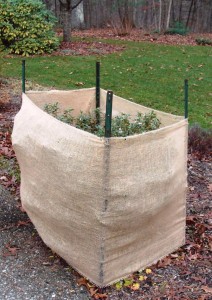
This simple enclosure of metal fence posts (from the summer veggie garden) and burlap will protect this tender Daphne while allowing air circulation
Protecting shrubs. Any plant that regularly fails to thrive after a tough winter needs extra protection. You can use many of the same techniques that work for roses for spring flowering hydrangeas that fail to bloom, as well as not-quite-hardy shrubs. Plants can be protected with wind screen or cages stuffed mulch, straw or leaves. Plants susceptible to branch break from heavy snow need special help. Tying branches together with heavy twine can be effective. For small plants, slatted structures allow good air flow while preventing crushing snow loads from building up.
Protecting new plantings. If you took advantage of fall nursery sales or just moved a few plants, now is the time to give newly planted shrubs some extra protection. Construct wind screens or create cages around new plants that you can stuff with dead leaves or straw. When the ground freezes, mulch over the areas of new roots to keep them cold throughout the winter.
Protecting perennials. One of the easiest ways to protect your perennials is to mulch the soil after the ground freezes. If we have a covering of snow, it protects perennials from the damage of being thrust out of the ground during frost and thaw cycles (January thaws). A covering of three inches of compost, hardwood mulch or shredded leaves can take the place of snow during dry winters or prolonged warm spells. And, come spring, the compost or leaves will improve the soil.
Indoor work.Cleaning tools before they are put away for the winter saves tools – and time – in the spring. Metal tools such as trowels, shovels and hoes should be washed of dirt, their digging edges sharpened and then coated with thin film of
oil to protect against rust. Cutting tools need to be thoroughly cleaned of dirt and sap, then sharpened and lightly oiled. Wooden handles should receive a light coating of furniture oil to keep them from drying out. After the last grass cutting, send your mower in for its annual tune-up. When you are ready to get going, your tools will be too.
While in the garage or garden shed, make note of old packages of herbicides and pesticides. Heat, cold and age all reduce the effectiveness of many of these products, but not their toxicity to the environment. Put them aside to dispose of at special collections centers or toxic material days held by town DPW. NEVER place them in the trash or pour them down the drain or out on the ground. The environment you save is the one you and your family live in.
December 2010
Yard Work Keep mowing the lawn as long as it grows—usually until the ground freezes. The mower should be set at just 2 inches. The leaves, fallen or blown in, you are also continuing to chop up, disintegrate over the winter, feeding the lawn and the tree roots below.
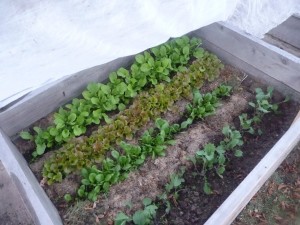 Vegetables in winter If you are lucky enough to have anything left in your vegetable garden—Brussels sprouts, kale, leeks, congratulations. Bring them in now and store in a cool garage or basement Mulch the root crops such as parsnips and rutabagas heavily with straw or chopped leaves and you will continue your harvest a little longer—until the ground freezes beneath the mulch. If you started lettuce, arugula, spinach or other cold weather crops in your cold frame, you will be dining on home grown salads through the holidays.
Vegetables in winter If you are lucky enough to have anything left in your vegetable garden—Brussels sprouts, kale, leeks, congratulations. Bring them in now and store in a cool garage or basement Mulch the root crops such as parsnips and rutabagas heavily with straw or chopped leaves and you will continue your harvest a little longer—until the ground freezes beneath the mulch. If you started lettuce, arugula, spinach or other cold weather crops in your cold frame, you will be dining on home grown salads through the holidays.
Reindeer yes, Deer no! If deer bedevil your yard during the winter, there are two steps to take to improve your plants chances. First, when the temperature goes over 40° you can spray the trees with a readily available repellent made from putrified eggs and garlic. The smell disappears for you in a few hours, but it continues to deter the deer for up to a month.
Second, wrap those plants the deer prefer with black plastic “chicken wire” and secure it to stakes placed a few inches away from the plants. The fencing will be virtually invisible to anyone admiring your winter landscape, but effective at keeping the deer from nibbling your trees and shrubs to death. Small plants, under four feet should also have a piece of fencing secured over the top so the deer cannot simply reach in to dine.
An excellent time to prune. Deciduous plants, those that lose their leaves in the winter, have gone dormant. . Examine the structure of the bare tree or shrub and decide what needs to be done to keep your plant growing the way you want. Start with the easy to spot dead or diseased wood, then crossing or rubbing branches. If you lack experience, a pruning class will teach you to see what needs to be done to keep your plants in shape.
When pruning evergreens always start at the bottom and work your way up so clippings don’t confuse the process. And remember to keep the bottom wider than the middle or top or you may end up with ‘bare legs’ syndrome.
Evergreen pruning has a second benefit. You can use the cuttings to make holiday arrangements! Don’t bother bringing in hemlocks, it sheds its needles almost immediately. Similarly holly must be keep in clean water and will still have a short life span. Leave the winter berries for the birds who need them for food. They too fall off and can disagree with small children or pets who find them on the floor. But cuttings from spruce, cedar, pine and fir make great decorations on their own and elegant arrangements when combined with red or white carnations.
Lights Up If you decorate with outdoor lights on your trees and shrubs be careful not to damage next spring’s flowers (by having a light pressed up against the bud) or break small branches either during installation or removal. Lights should be placed on the plants and removed when the temperature is above freezing because the branches are more flexible in warmer weather.
* * * * *
Finish cleaning the garden. Eastern Massachusetts’ rainy fall has confounded many of our clean-up schedules but do finish before the ground freezes. The lawn needs a last mowing and you can do two chores at once by using a mulching mower to chop any remaining leaves into the grass. Perennials are generally easier to cut down now and a thorough clean-up of beds can remove disease and insects leftover from the growing season. Finally keep any new plantings watered until the ground freezes. Then stay off the frozen ground.
Having blue (ribbon) thoughts? Plants to be entered into the 2010 Blooms! amateur horticulture competition must be owned and grown by the exhibitor before December 13, 2009. If you are considering entering, you must acquire any new plants by that date. Check the details of the competition at masshort.org and go to Blooms! for full information.
Cutting your own Christmas tree is better for the environment than buying one pre-cut. Many of those trees are transported long distances and far too many of them end up not being purchased, increasing the waste. A tree cut locally is fresher and great family fun. After Christmas, use loppers to remove branches from your tree and use the boughs to cover gardens, keeping them from suffering from any freeze and thaw cycles as the winter progresses.
Christmas beyond poinsettias! Poinsettias can be handsome, colorful additions to the home for the holiday, but why not try something a little more unusual? I was thrilled when I discovered cyclamens. Bright and colorful, they are low-maintenance houseplants with long lasting flowers in shades of pink, red and purple or white. If you keep them cool and moist after they finish blooming, they will reward you more blooms in the spring and will surprise you with another bloom next winter.
